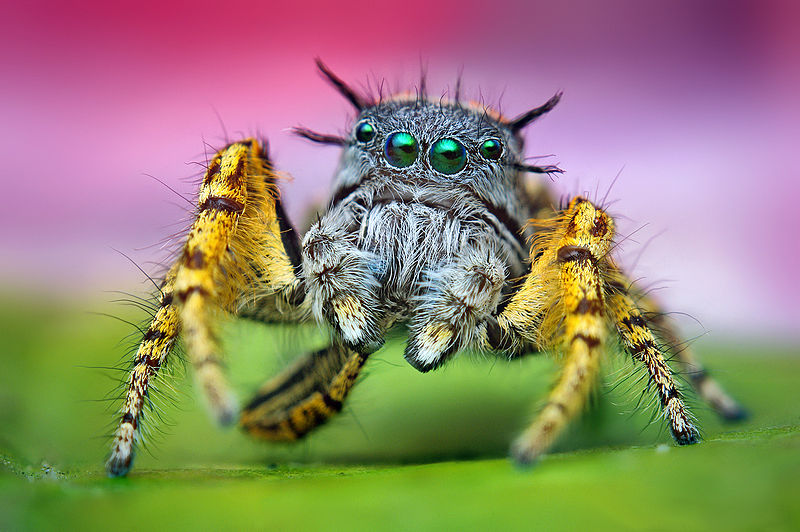Most people have experienced fear at some point during their lives. Unfortunately for many, one of the most widely spread fears is that of spiders (arachnophobia). Spiders are a highly successful group of organisms that can be found almost every terrestrial environment. In other words, if you’re an arachnophobe, your life has enormous the potential to be full of fear. Although spiders in certain localities can be highly venomous, spiders in the United Kingdom are, for the most part, harmless. By replacing fear with a healthy respect and potentially even a bit of admiration – embracing spiders as a part of your worlds can make things a little easier. After all, spiders are indeed a significant part of the ‘smaller majority’.
One potentially effective way to become a little friendlier with the fascinating world of arachnids is through a characteristic group known as the jumping spiders (Araneae: Salticidae). This group has more than 5,000 described species and can be found on all continents with the exception of Antarctica. Easily identified by their four sets of eyes, and distinctively shaped cephalothorax (fusion of head and thorax), these beautiful creatures are a fantastic introduction to all-things eight-legged.

A gorgeous example of a jumping spider: Phidippus mystaceus
Photo by Thomas Shahan – Wikimedia Commons
Jumping spiders will not hurt you
Jumping spiders use their acute eye-sight to track down prey, and ambush using quick movements. Due to their small size, and voracious appetite for insects – jumping spiders do not have any interest in harming humans. In fact these brave spiders generallywill not flee upon spotting a human, but will maintain a respectful distance. In fact, jumping spiders are so curious that you are likely to catch one spinning and re-positioning just to get a better look at you.

Fuzzier than a panda, smaller than a pea – Photo by James Niland: Wikimedia Commons
Jumping spiders like to boogie
Jumping spiders are well known for their complex behaviour. One behaviour that is particularly well studied is the courtship dance that males use to attract females. Males engage in a variety of different moves to impress the females: pumping their palpi (elongated segments that serve as sensory receptors), scuttling quickly from side to side, kicking their legs out to the side like a cabaret dancer, and even rapidly raising and lowering of the abdomen (a loose spider equivalent of an abdominal thrust). Pretty sexy indeed.
Here’s a video showing the elaborate courtship display of the Coastal Peacock Spider (Maratus speciosus):
Jumping spiders are like eight-legged track and field Olympians
Some species of jumping spiders are able to jump more than 50 times their body length! This is equivalent to a 2m-tall person jumping lengthwise over a football pitch! Jumping spiders achieve this through rapidly increasing the blood pressure within their legs causing an almost instantaneous leg extension – this launches the spider through the air. Compared to the world record for long jump set by 1.88m-tall Mike Powell, 8.95 meters seems a little on the short side. As they say, everything is relative!
Jumping spiders are masters of disguise
A final characteristic that allows jumping spiders to act as a perfect transition from spider-loathing to spider-loving is their ability to disguise themselves as something else. Jumping spiders are particularly good at looking like ants – a prime example of Batesian mimicry. Other species exhibit aposematic colouring, resembling unpalatable beetles and keeping would-be-predators at bay. Some mimic other arthropods like pseudoscorpions, while others mimic something a little less appetizing – anyone care for a bird-dropping?

An example of the jumping spider diversity (top row), and the forms that they mimic (below).
Left to Right: Ant, Pseudoscorpion, Beetle, Bird-Dropping
Jumping spider photos by Wayne Maddison – Tree of Life
As warmer temperatures roll through, remember to keep your eyes peeled for these gentle beasts. Rock walls, sides of homes, and sunny surfaces are all wonderful habitats to enjoy these magnificent creatures. As a precaution, please understand that a love of jumping spiders can rapidly transform into a deeper, and wider love for all arachnids.
References:
Maddison, W. 2014. Salticids in Disguise. In Tree of Life. http://tolweb.org/accessory/Salticids_in_Disguise?acc_id=63.
Reiskind, J. 1977. Ant-mimicry in Panamanian clubionid and salticid spiders (Araneae: Clubionidae, Salticidae). Biotropica, 1-8.
Richman, D. B., & Jackson, R. R. 1992. A review of the ethology of jumping spiders (Araneae, Salticidae). Bulletin of the British Arachnological Society,9(2), 33-37.
![Salticids: A Gateway to Loving Spiders Most people have experienced fear at some point during their lives. Unfortunately for many, one of the most widely spread fears is that of spiders […]](/wp-content/uploads/2013/12/Botany-Artist-Iona-Richards-Color-Designer-Thao-Do.png)